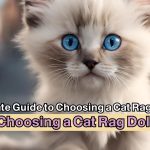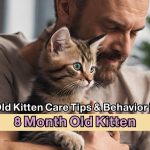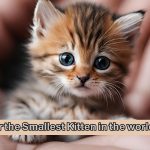When it comes to taking care of our beloved feline friends, providing them with the right nutrition is vital for their overall health and well-being. But with so many options available and conflicting advice out there, it can be challenging to determine the best cat feeding chart for your furry companion. How much should you feed them? When should you feed them? And what should their diet consist of?
In this article, we will guide you through the process of creating an optimal cat feeding chart that will ensure your cat gets all the nutrients they need for a healthy life. We will delve into the importance of a cat feeding guide and show you how to design a cat food schedule tailored to your cat’s individual needs.
Get ready to discover the key to maintaining your cat’s health and happiness through proper nutrition. Let’s embark on this journey together as we unravel the mysteries of an optimal cat feeding chart!
Understanding Your Cat’s Nutritional Needs
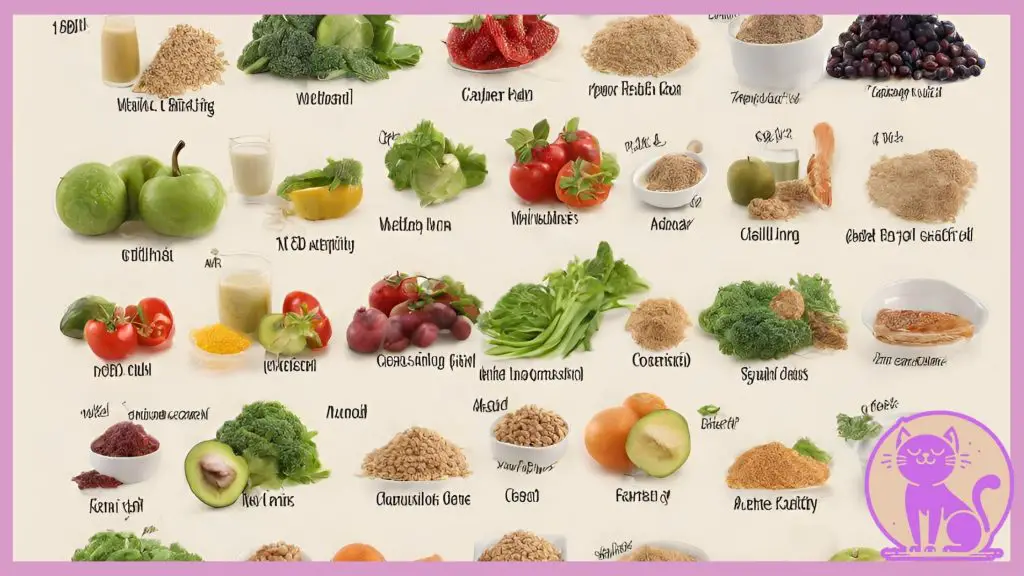
Before we delve into the cat feeding chart, it’s crucial to understand your cat’s nutritional needs. Providing your feline friend with a balanced and nutritious diet is vital for their overall health and well-being. A well-planned kitten feeding chart plays a significant role in ensuring appropriate growth and development.
Creating a proper cat nutrition schedule involves considering essential nutrients and feeding frequencies that align with your cat’s specific requirements. Cats have unique dietary needs, and their nutritional needs change as they grow and age. By understanding these needs, you can provide the best diet for your beloved pet.
Elements of a Proper Cat Nutrition Schedule
A proper cat nutrition schedule consists of various elements that contribute to your cat’s overall health. These elements include:
- Protein: Cats are obligate carnivores, meaning they require a high amount of protein in their diet. Quality animal-based protein sources, such as chicken or fish, should be the foundation of your cat’s meals.
- Carbohydrates: Although cats don’t have a biological need for a high-carbohydrate diet, small amounts of carbohydrates can be beneficial. Choose complex carbohydrates like whole grains or vegetables to provide fiber and energy.
- Fats: Healthy fats are essential for your cat’s skin, coat, and overall health. Include a moderate amount of fats from sources like fish oil or chicken fat in their diet.
- Vitamins and minerals: Cats require a balanced mix of vitamins and minerals to support their immune system, bone health, and overall vitality. These essential nutrients can be obtained through high-quality cat food or appropriate supplements.
- Water: They should have access to fresh water at all times. Ensure that their water bowls are always clean and refilled regularly. Proper hydration is crucial for maintaining optimal health.
Understanding your cat’s nutritional needs and implementing a proper feeding schedule can help prevent nutritional deficiencies and promote a long and healthy life for your furry companion.
| Life Stage | Nutritional Needs | Feeding Frequency |
|---|---|---|
| Kitten | High in protein, calcium, and essential nutrients for growth and development. | 3-4 meals per day |
| Adult | Moderate protein and essential nutrients to support overall health. | 2 meals per day |
| Senior | Lower calories, controlled protein, and additional supplements for age-related conditions. | 2 meals per day |
Remember, while a general cat feeding chart can serve as a starting point, individual cat’s needs may vary. Factors such as activity level, weight, and health conditions should also be considered in creating a cat nutrition schedule. Consulting with a veterinarian is always recommended to ensure your cat receives the best possible nutrition.
Types of Cat Food
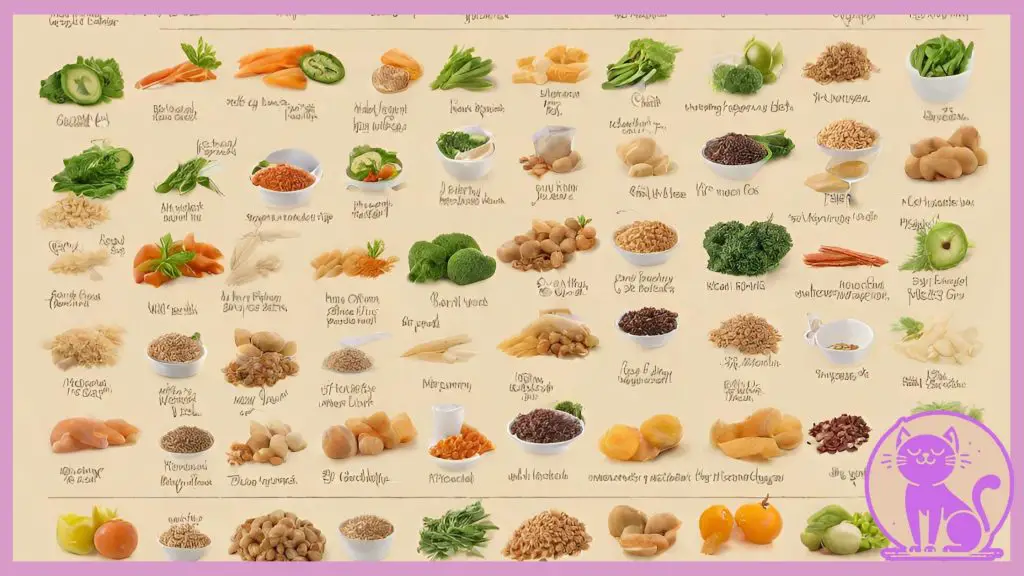
Choosing the right type and amount of cat food is critical for maintaining your cat’s overall health and well-being. Feeding your feline companion the correct portions of food is essential to ensure they receive the necessary nutrients without overeating. In this section, we will guide you through determining the best cat food portions for your cat, taking into account factors such as their age, weight, and activity level.
When determining the best cat food portions, it’s important to consider your cat’s individual needs. Kittens, for example, require more frequent meals and smaller portion sizes to support their growth and development. Adult cats, on the other hand, have different nutritional requirements based on their activity levels and weight management goals.
It’s recommended to consult with your veterinarian to determine the appropriate portion sizes for your cat. They can provide personalized recommendations based on your cat’s specific needs and health conditions.
In addition to portion sizes, it’s also important to consider the type of cat food you are feeding your feline friend. There are various options available, including dry kibble, wet canned food, and even raw or homemade diets. Each type of cat food has its advantages and considerations, so it’s essential to choose one that aligns with your cat’s dietary requirements and preferences.
To help you make an informed decision, we have provided a comparison table below that outlines the benefits and considerations of different types of cat food:
| Type of Cat Food | Benefits | Considerations |
|---|---|---|
| Dry Kibble | – Convenient and easy to store – Promotes dental health – Cost-effective | – Less moisture content – Can cause dehydration if the cat doesn’t drink enough water |
| Wet Canned Food | – High moisture content – Palatable and appealing to cats – Provides hydration | – More expensive – Shorter shelf life once opened – May contribute to dental issues if not balanced with dry food |
| Raw/Homemade | – Allows for complete control over ingredients – Can be tailored to specific dietary needs | – Requires careful meal planning to ensure balanced nutrition – Time-consuming to prepare |
Remember, the right cat food portions and type of cat food can play a significant role in your cat’s overall health. Be sure to consider their unique needs and seek professional guidance when necessary. By providing a balanced and nourishing diet, you can promote a long and healthy life for your beloved feline companion.
Dry vs. Wet Cat Food
The debate between dry and wet cat food is a common topic among cat owners. Both options have their advantages and disadvantages, so it’s essential to consider your cat’s specific needs when making a decision. Let’s explore the pros and cons of each to help you make an informed choice for your feline friend’s diet.
Benefits of Dry Cat Food
Dry cat food, also known as kibble, is a convenient and cost-effective option for many cat owners. Here are some key benefits:
- Convenience: Dry cat food can be left out for your cat to graze on throughout the day without worrying about spoilage. It’s an ideal choice for cat parents with a busy schedule.
- Dental Health: The crunchy texture of dry cat food can help remove plaque and tartar buildup, promoting better oral health.
- Dietary Variety: Dry cat food is available in a wide range of flavors and formulas, catering to different taste preferences and dietary restrictions.
Benefits of Wet Cat Food
Wet cat food, also known as canned or moist food, offers several benefits for your cat’s health and well-being:
- Hydration: Wet cat food has a high moisture content, which helps keep your cat hydrated and supports urinary tract health.
- Promotes Appetite: The rich aroma and flavor of wet cat food can entice even picky eaters and encourage proper nutrition.
- Weight Management: Wet cat food is generally lower in carbohydrates and higher in protein, which can aid in weight management and the prevention of obesity.
Drawbacks of Wet Cat Food
While wet cat food has numerous advantages, it is not without drawbacks:
- Storage and Freshness: Wet cat food needs to be refrigerated after opening and may require more frequent purchases due to its shorter shelf life.
- Cost: Wet cat food can be more expensive compared to dry food, especially for those on a tight budget.
- Dental Health: Wet cat food’s soft texture does not provide the same dental benefits as dry food. Regular dental care is essential for cats consuming primarily wet food.
Feeding Frequency for Cats
Regardless of whether you choose dry or wet cat food, establishing a feeding schedule is crucial. Cats are natural grazers, so dividing their daily food portions into 2-3 meals is recommended. This helps prevent overeating and maintains their energy levels throughout the day.
Below is a general feeding frequency guideline for cats:
| Age | Feeding Frequency |
|---|---|
| Kittens (6-12 weeks) | 4-6 small meals per day |
| Adult Cats (1 year and older) | 2-3 meals per day |
| Senior Cats (7 years and older) | 2 meals per day |
Remember, every cat is unique, and their specific nutritional needs may vary. It’s essential to consult with your veterinarian to determine the best cat feeding chart and food schedule for your feline friend.
Transitioning to a New Diet
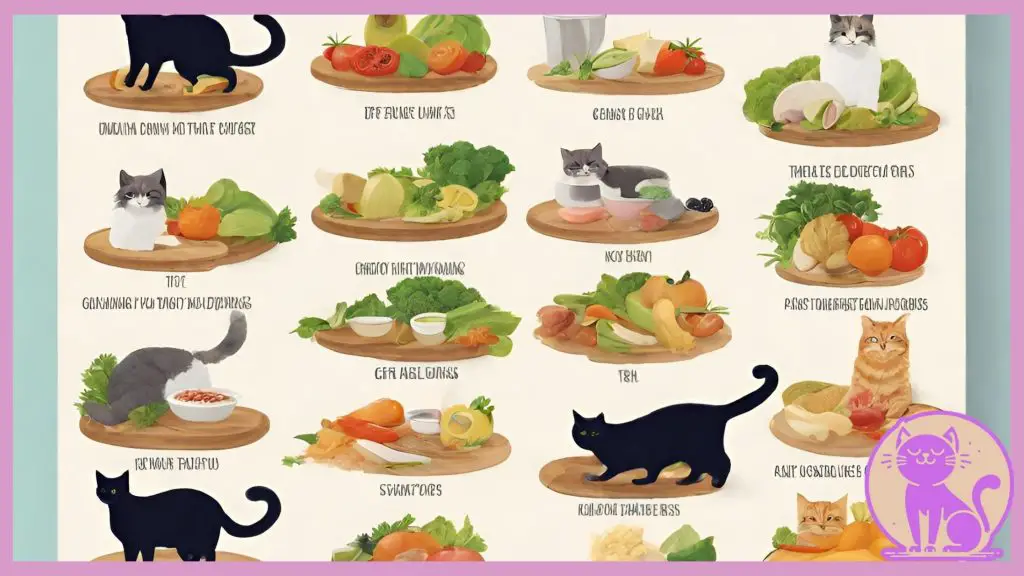
It’s important to approach transitioning your cat to a new diet with care and patience. Abruptly changing their food can lead to digestive upset and refusal to eat. In this section, we will provide feline feeding recommendations to help make the transition as smooth as possible. Additionally, we will highlight the significance of maintaining a proper cat nutrition schedule throughout the process.
Proper Cat Nutrition Schedule during Transition
During the transition phase, it’s important to maintain a consistent cat nutrition schedule. Feeding your cat at the same times each day helps regulate their digestion and establishes a routine that they can rely on. This consistency aids in the smooth transition to the new diet.
Stick to the recommended portion sizes for your cat’s age, weight, and activity level. Gradual food changes may require adjusting the portion sizes accordingly. Consult your veterinarian for specific guidance on portion control and the appropriate feeding schedule for your cat during the transition period.
| New Diet Transition Guidelines |
|---|
| Start by mixing 25% of the new food with their current diet. |
| Gradually increase the proportion of the new food over a week. |
| Monitor for any signs of digestive distress during the transition. |
| Maintain a consistent cat nutrition schedule during the transition. |
| Consult your veterinarian for portion control and schedule adjustments. |
Special Dietary Considerations
Cats with special dietary needs, such as allergies or medical conditions, require extra attention when it comes to their nutrition. In this section, we will provide you with a comprehensive cat feeding guide to help you navigate feeding your cat with specific dietary requirements. We will also discuss the modification of the cat food schedule to accommodate these unique situations while ensuring optimal nutrition and well-being.
Dietary Modifications for Cats with Allergies
**Cat feeding guide** is particularly valuable when dealing with cats that have allergies. Allergies in cats can manifest as skin irritations, gastrointestinal issues, or respiratory problems. To manage allergies, it is essential to identify and eliminate the allergen from the cat’s diet. This may involve feeding a hypoallergenic diet or choosing a cat food that excludes the allergenic ingredient. Additionally, consulting with a veterinarian may provide further guidance on the necessary dietary modifications.
Feeding Cats with Medical Conditions
**Cat feeding guide** also plays a crucial role in managing cats with medical conditions. Conditions such as diabetes, renal disease, or urinary tract issues may require special dietary considerations. These conditions often necessitate specific nutrient balance, controlled calorie intake, or restricted ingredient choices. Working closely with a veterinarian will help determine the appropriate **cat food schedule** and dietary modifications to address these conditions and maintain your cat’s overall health.
Gradual Transition and Monitoring
When implementing dietary modifications for cats with special needs, it is essential to introduce changes gradually. Cats can be sensitive to sudden dietary changes, and a gradual transition allows their digestive systems to adjust. Additionally, closely monitoring your cat’s response to the changes, including any improvements or adverse effects, is crucial. Regular check-ups with a veterinarian are recommended to ensure your cat’s well-being is consistently monitored throughout the process.
Feeding Tips and Tricks
Feeding time is not just about providing nourishment for your feline friend, but also an opportunity to strengthen your bond and enhance their overall well-being. With a few simple tips and tricks, you can transform mealtime into a positive and enjoyable experience for both you and your cat.
Mindful Mealtime
Creating a calm and peaceful environment during feeding can make a big difference in your cat’s comfort and digestion. Find a quiet spot free from distractions, such as loud noises or other pets, and establish a consistent feeding routine. Cats are creatures of habit and thrive on predictability, so try to feed them at the same time each day to maintain a sense of routine.
Serve Meals in Appropriate Portions
Serving the correct cat food portions is crucial for maintaining your cat’s health and preventing issues like obesity or undernourishment. Every cat is unique, so it’s essential to consider their age, weight, and activity level when determining the appropriate amount of food. Consult a cat feeding guide or consult your veterinarian for specific guidelines tailored to your cat’s individual needs.
Choose the Right Feeding Bowl
The type of bowl you use can impact your cat’s eating experience. Opt for shallow, wide bowls that allow your cat to access their food easily. Additionally, consider using stainless steel or ceramic bowls, as they are easier to clean and less likely to harbor bacteria compared to plastic bowls.
| Feeding Tips | Benefits |
|---|---|
| Use puzzle feeders or interactive toys | Stimulates mental activity and keeps your cat entertained |
| Rotate food flavors and textures | Prevents boredom and adds variety to their diet |
| Monitor water intake | Ensures your cat stays hydrated for optimal health |
| Avoid free-feeding | Prevents overeating and promotes better portion control |
| Observe your cat’s eating habits | Allows you to identify any changes in appetite or behavior that may require veterinary attention |
Mealtime Etiquette
When it comes to feeding your cat, it’s essential to establish some basic mealtime etiquette. Avoid disturbing your cat while they are eating, as this can cause stress or anxiety. Allow them to eat at their own pace and refrain from removing their food abruptly. If your cat has not finished their meal, simply cover the bowl or remove it after a reasonable amount of time to prevent spoilage.
By following these feeding tips and tricks, you can make mealtime a positive experience for both you and your feline companion. Remember to consult a cat feeding guide and determine the best cat food portions based on your cat’s individual needs. With love and care, you can ensure your cat’s overall well-being and happiness.
Monitoring Your Cat’s Weight

The Importance of a Kitten Feeding Chart
Regularly monitoring your cat’s weight is crucial for their overall health. A kitten feeding chart can be an invaluable tool in ensuring that your furry friend is growing and gaining weight properly.
Tracking your kitten’s weight on a feeding chart allows you to identify any potential issues early on and make necessary adjustments to their diet. It provides a visual representation of their growth trajectory, giving you peace of mind that they are thriving.
Adapting Cat Food Portions for Adult Cats
As your cat transitions into adulthood, maintaining a healthy weight becomes increasingly important. Properly portioned meals are key to achieving this.
Determining the best cat food portions for your adult cat involves considering various factors such as their activity level, metabolism, and overall body condition. It is essential to strike the right balance to prevent obesity or malnutrition.
Consulting with your veterinarian or a professional cat nutritionist can help you create a tailored feeding plan and cat food schedule that aligns with your cat’s individual needs. They can provide valuable guidance on the specific portions and frequency of feeding that will support your cat’s optimal weight.
Weight Monitoring Tips and Recommendations
In addition to using a kitten feeding chart and adjusting cat food portions, there are other effective measures you can take to monitor and maintain your cat’s weight:
- Regularly weigh your cat using a reliable pet scale to track their progress.
- Observe your cat’s body condition by feeling their ribs and waistline.
- Incorporate exercise and playtime into your cat’s daily routine to help manage their weight and stimulate their metabolism.
- Avoid free-feeding and instead establish a consistent feeding schedule to regulate portion control.
By following these monitoring tips and utilizing a kitten feeding chart, you can ensure that your cat maintains a healthy weight throughout their life, promoting their overall well-being and longevity.
Common Feeding Mistakes to Avoid
Even with the best intentions, cat owners can sometimes make feeding mistakes that impact their cat’s health. It’s important to understand these pitfalls to ensure your cat’s nutritional needs are consistently met. Here are some common feeding mistakes to avoid:
- Overfeeding: One of the most common mistakes is overfeeding your cat. While it’s natural to want to spoil your furry friend, excessive food can lead to weight gain, obesity, and related health issues. Follow a cat feeding guide and stick to the recommended portions to maintain a healthy weight for your cat.
- Inconsistent Feeding Schedules: Cats thrive on routine, and inconsistent feeding can disrupt their digestive systems. Establish a regular cat food schedule, giving them meals at the same time each day. This helps regulate their metabolism and ensures proper digestion.
- Feeding Improper Foods: Not all human foods are safe for cats, and feeding them the wrong foods can be harmful. Avoid feeding your cat items such as chocolate, onions, garlic, grapes, and caffeine, as these can be toxic to felines. Stick to a cat food schedule that includes nutritionally balanced, high-quality cat food designed for their specific dietary needs.
- Ignoring Water Intake: Water is essential for your cat’s overall health and well-being. Some cat owners overlook the importance of providing fresh water daily. Ensure your cat has access to clean water at all times, especially if you’re feeding them dry cat food, as it helps prevent dehydration.
- Skipping Veterinary Guidance: While cat feeding guides can provide helpful information, it’s crucial to consult with your veterinarian for personalized advice. Each cat is unique, and their nutritional needs may vary based on factors such as age, weight, and medical conditions. Your veterinarian can provide tailored recommendations to ensure your cat’s diet is appropriate and meets their specific needs.
By avoiding these common feeding mistakes and following a cat feeding guide, you can provide your feline companion with the proper nutrition they need for a healthy and happy life.
| Feeding Mistake | Consequences | Prevention |
|---|---|---|
| Overfeeding | Weight gain, obesity, related health issues | Follow recommended portions, monitor weight |
| Inconsistent Feeding Schedules | Disrupted digestion, metabolism issues | Establish regular feeding schedule |
| Feeding Improper Foods | Toxicity, potential harm to cat’s health | Stick to nutritionally balanced cat food |
| Ignoring Water Intake | Dehydration, urinary tract issues | Provide fresh water daily |
| Skipping Veterinary Guidance | Lack of personalized advice, improper diet | Consult with veterinarian for recommendations |
Conclusion
In this article, we have provided an optimal cat feeding chart and comprehensive guidelines to ensure your cat receives the perfect balance of nutrition for a healthy life. By following a cat feeding guide and creating a well-planned cat food schedule, you can promote your feline friend’s well-being and longevity.
Remember to monitor their weight, make necessary dietary adjustments, and avoid common feeding mistakes. Your cat’s health is in your hands!
FAQ
Q: What is a cat feeding chart?
A: A cat feeding chart is a guide that outlines the recommended portions and feeding frequencies for cats based on their age, weight, and activity level. It helps ensure that your cat receives the appropriate amount of nutrition to maintain a healthy weight and overall well-being.
Q: Why is a cat feeding guide important?
A: A cat feeding guide is important because it provides you with the necessary information on how much and how often to feed your cat. It ensures that your cat gets the right balance of essential nutrients and helps prevent underfeeding or overfeeding, which can lead to health issues.
Q: How do I create a cat food schedule?
A: To create a cat food schedule, start by determining the recommended daily portion of food for your cat based on their age, weight, and activity level. Divide the portion into multiple meals throughout the day, ensuring a consistent feeding time. Adjust the schedule as your cat’s needs change with age or health conditions.
Q: What is a kitten feeding chart?
A: A kitten feeding chart is a specialized guide that provides recommendations for feeding kittens based on their age and growth stages. It ensures that kittens receive the appropriate nutrients and calories they need for optimal development.
Q: What is a proper cat nutrition schedule?
A: A proper cat nutrition schedule includes feeding your cat a well-balanced diet that meets their specific needs. It consists of determining the right amount and frequency of meals, offering a mix of high-quality cat food, and ensuring access to fresh water. Regular veterinary check-ups can also help fine-tune the nutrition schedule as your cat ages or experiences any health changes.
Q: How do I determine the best cat food portions?
A: Determining the best cat food portions depends on several factors, including your cat’s age, weight, and activity level. It is essential to follow the feeding guidelines provided by the cat food manufacturer and consult with your veterinarian if you have any concerns or specific dietary requirements for your cat.
Q: How much should I feed a cat?
A: The amount you should feed a cat depends on their age, weight, and activity level. As a general guideline, adult cats typically require 20-25 calories per pound of body weight per day. However, it is essential to consider individual factors and consult with your veterinarian to determine the appropriate portion size for your cat.
Q: What are the pros and cons of dry and wet cat food?
A: Dry cat food, also known as kibble, offers convenience, dental benefits, and longer shelf life. Wet cat food, on the other hand, provides higher moisture content and can benefit cats with urinary tract issues. Both have their advantages and disadvantages, so it is best to consider your cat’s specific needs and consult with your veterinarian to make an informed choice.
Q: How often should I feed my cat?
A: The feeding frequency for cats depends on various factors, including their age and the type of food they consume. As a general recommendation, adult cats should be fed two meals a day, while kittens require more frequent meals. Consult with your veterinarian to determine the ideal feeding frequency for your cat based on their individual needs.
Q: How do I transition my cat to a new diet?
A: To transition your cat to a new diet, mix small amounts of the new food with their current food gradually. Start with a small proportion of the new food and increase it over a week or two until it replaces the old food entirely. This gradual transition helps prevent digestive upset and allows your cat to adjust to the new diet smoothly.
Q: How do I modify the cat food schedule for cats with special dietary needs?
A: Cats with special dietary needs, such as allergies or medical conditions, often require a modified cat food schedule. This may involve following specific feeding guidelines prescribed by your veterinarian, offering specialized cat food, or administering medication with meals. It is crucial to consult your veterinarian for tailored recommendations to ensure your cat’s nutritional requirements are met.
Q: What are some feeding tips and tricks for cats?
A: Feeding time can be a bonding experience for you and your cat. Here are some feeding tips and tricks: establish a routine, use puzzle feeders for mental stimulation, avoid free-feeding, provide fresh water at all times, and monitor your cat’s eating habits and weight for any changes.
Q: How do I monitor my cat’s weight?
A: Regularly monitoring your cat’s weight is important for their overall health. Use a scale to weigh your cat periodically and make adjustments to their diet if needed. For kittens, a kitten feeding chart can help track their growth and weight gain. If you notice significant weight changes, consult your veterinarian for further evaluation and guidance.
Q: What are common feeding mistakes to avoid?
A: Common feeding mistakes to avoid include overfeeding, underfeeding, inconsistent feeding schedules, offering inappropriate human food, and neglecting to adjust the portion size as your cat ages or changes activity levels. Following a cat feeding guide, consulting with your veterinarian, and being mindful of your cat’s individual needs can help prevent these mistakes.





